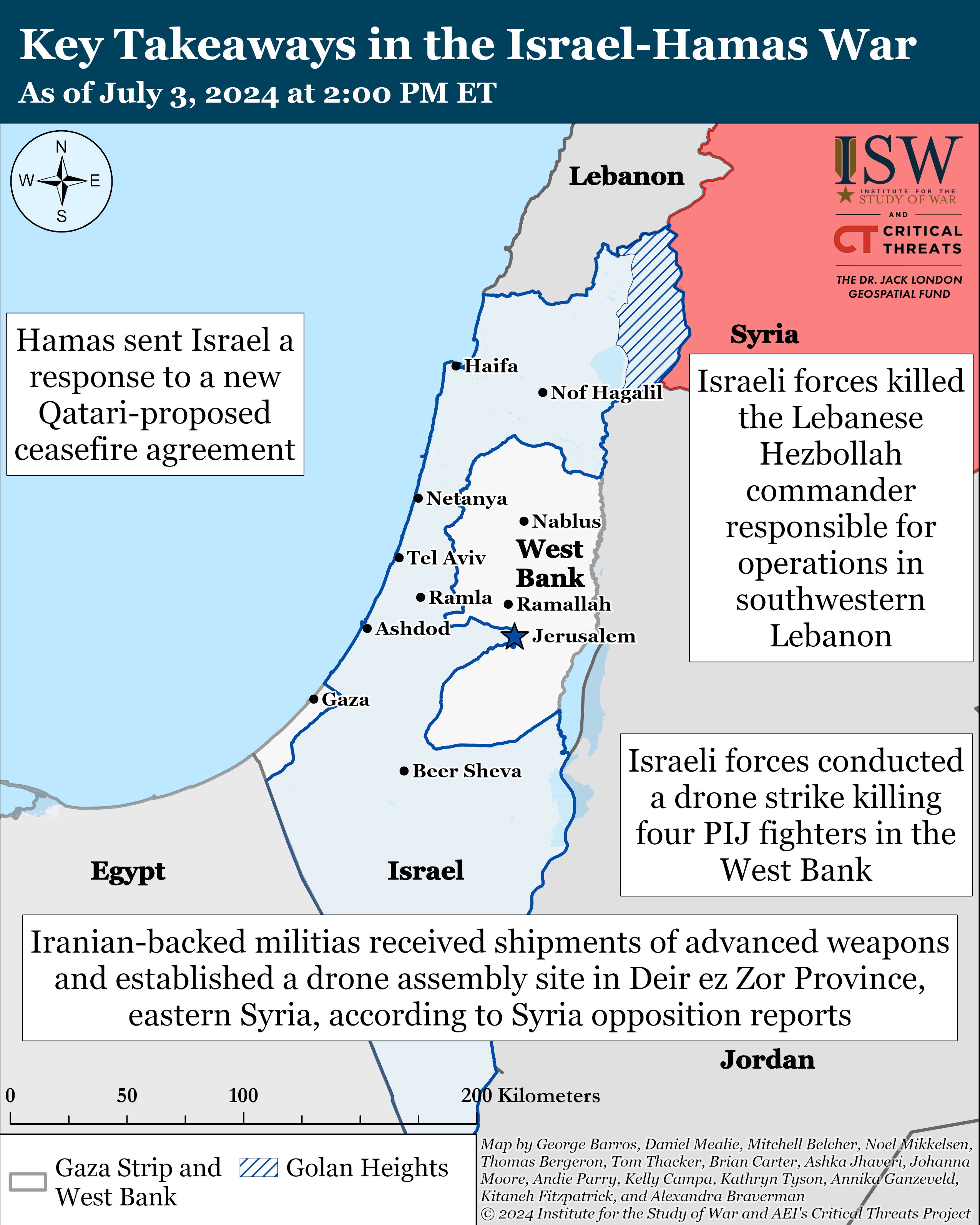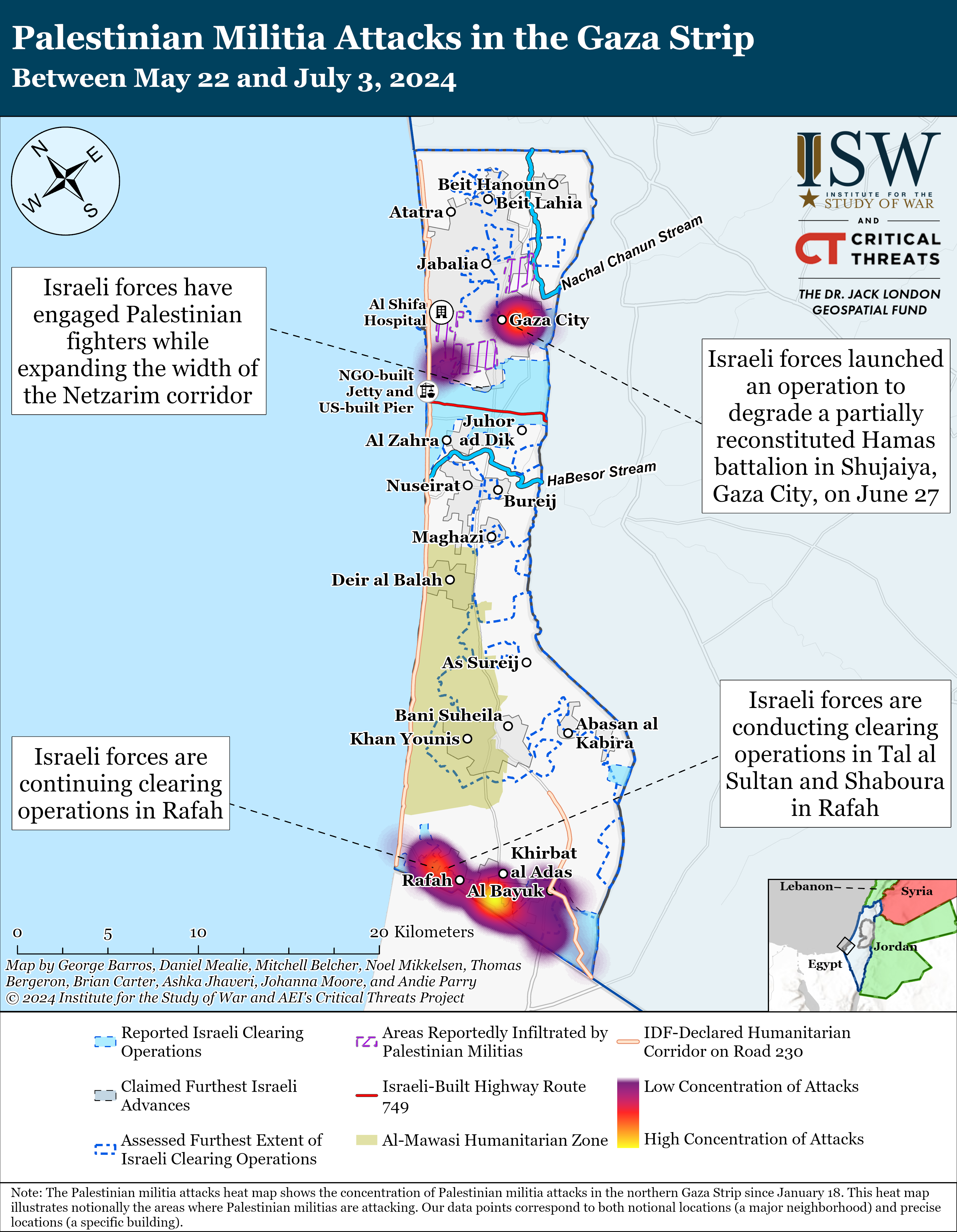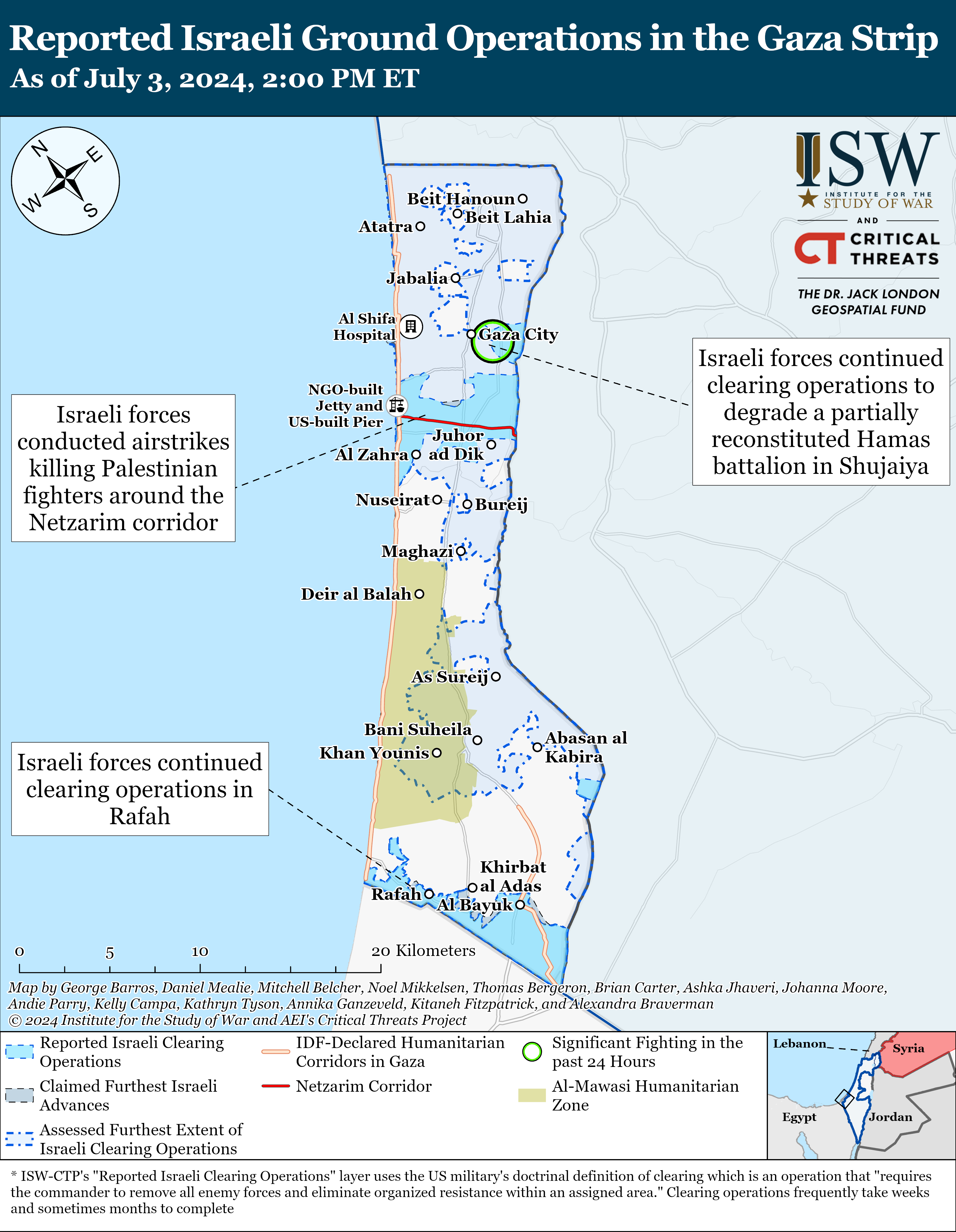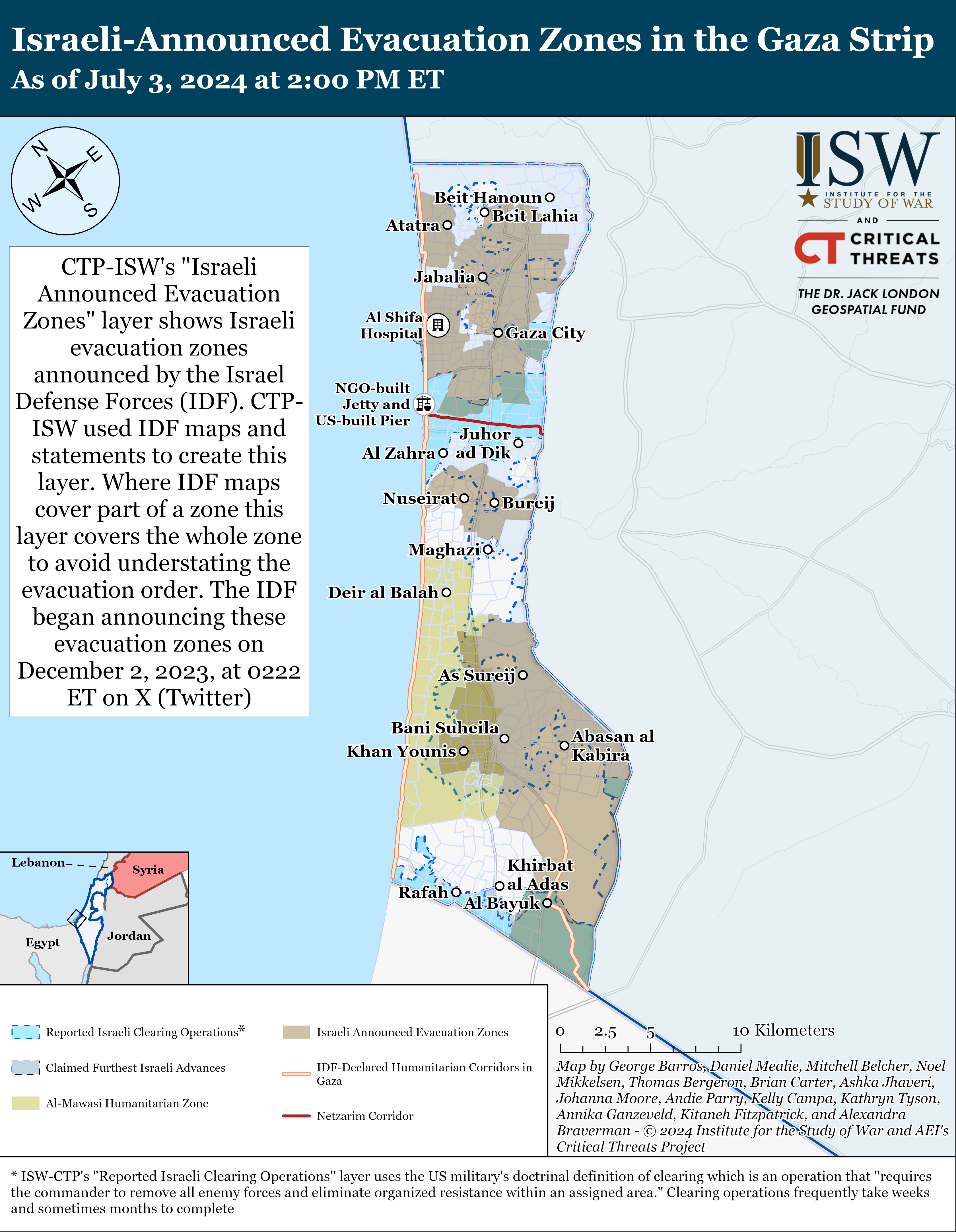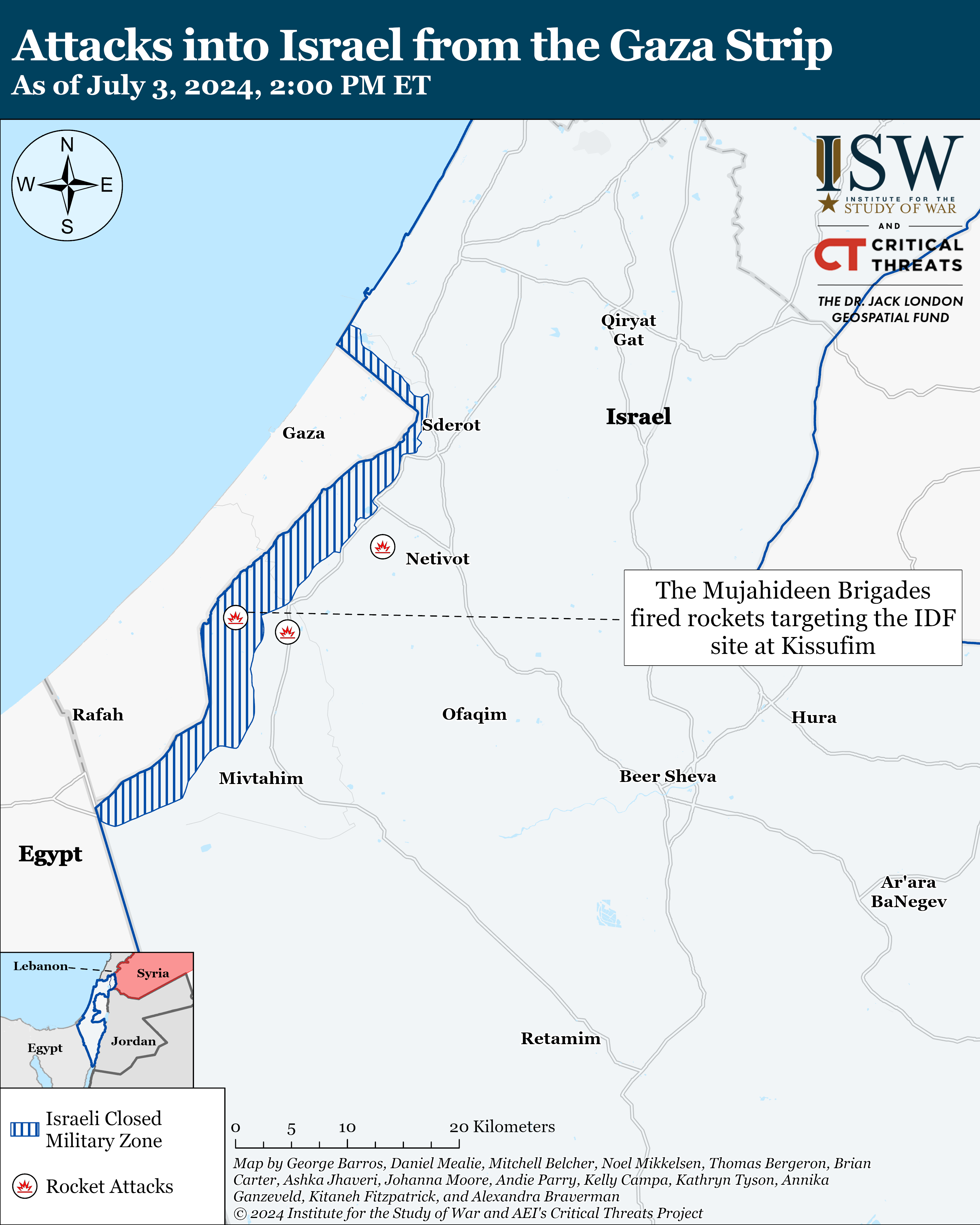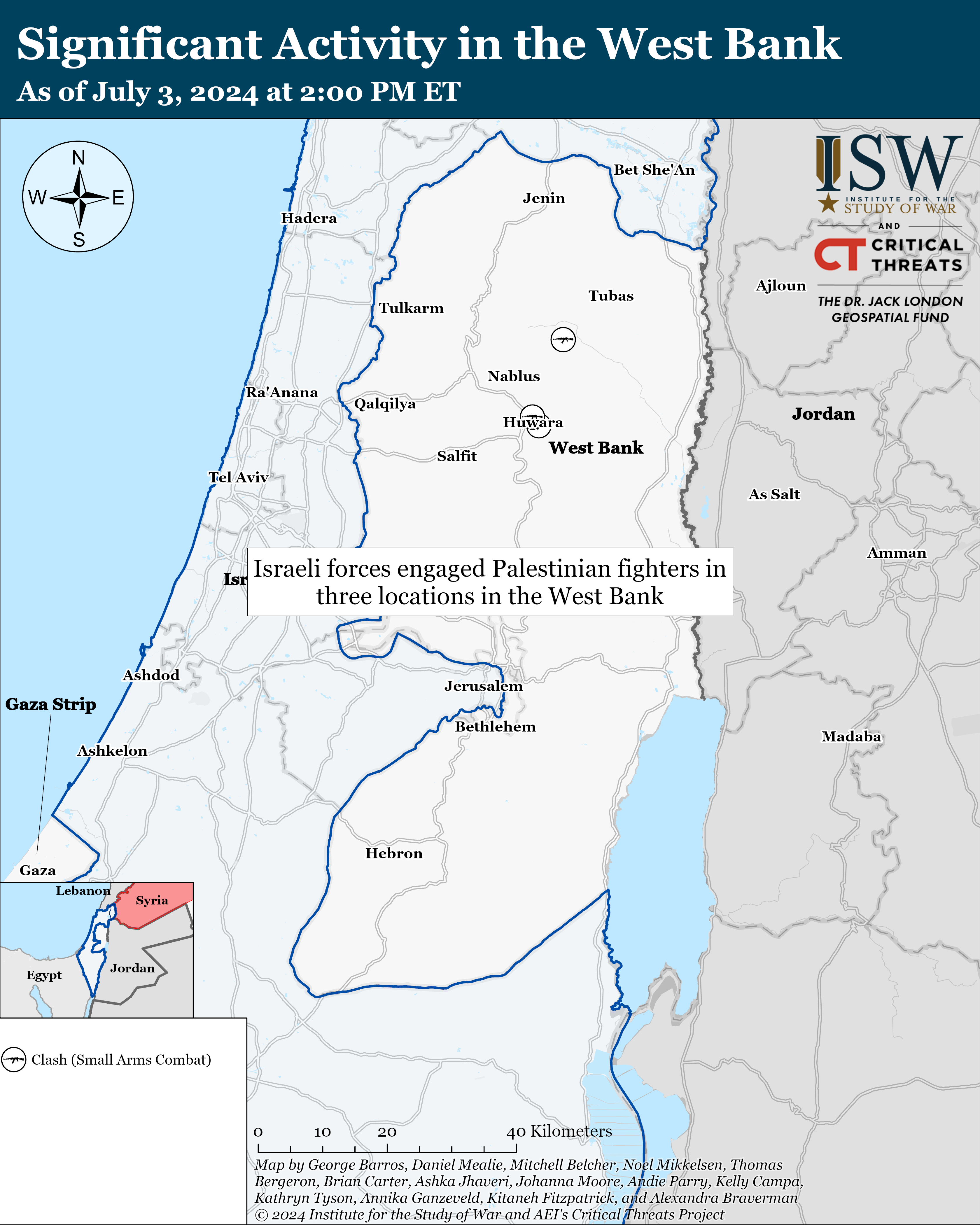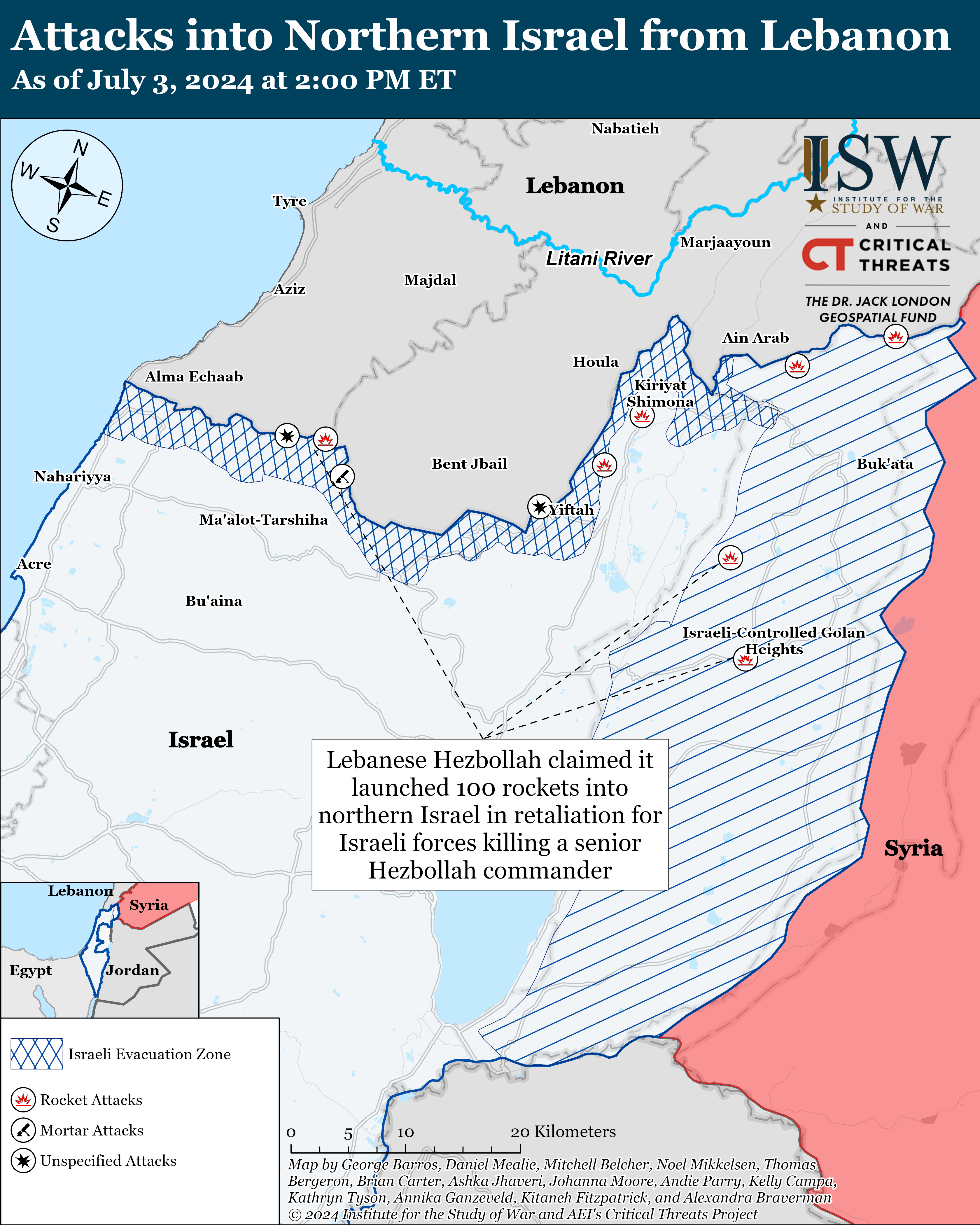 |
 |
Iran Update, July 3, 2024
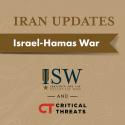
Iran Update, July 3, 2024
Kathryn Tyson, Annika Ganzeveld, Johanna Moore, Alexandra Braverman, Kelly Campa, Siddhant Kishore, Katherine Wells, and Nicholas Carl
Information Cutoff: 2:00 pm ET
The Iran Update provides insights into Iranian and Iranian-sponsored activities abroad that undermine regional stability and threaten US forces and interests. It also covers events and trends that affect the stability and decision-making of the Iranian regime. The Critical Threats Project (CTP) at the American Enterprise Institute and the Institute for the Study of War (ISW) provides these updates regularly based on regional events. Click here to see CTP and ISW’s interactive map of Israeli ground operations. This map is updated daily alongside the static maps present in this report. Click here to subscribe to the Iran Update.
CTP-ISW defines the “Axis of Resistance” as the unconventional alliance that Iran has cultivated in the Middle East since the Islamic Republic came to power in 1979. This transnational coalition is comprised of state, semi-state, and non-state actors that cooperate to secure their collective interests. Tehran considers itself to be both part of the alliance and its leader. Iran furnishes these groups with varying levels of financial, military, and political support in exchange for some degree of influence or control over their actions. Some are traditional proxies that are highly responsive to Iranian direction, while others are partners over which Iran exerts more limited influence. Members of the Axis of Resistance are united by their grand strategic objectives, which include eroding and eventually expelling American influence from the Middle East, destroying the Israeli state, or both. Pursuing these objectives and supporting the Axis of Resistance to those ends have become cornerstones of Iranian regional strategy.
We do not report in detail on war crimes because these activities are well-covered in Western media and do not directly affect the military operations we are assessing and forecasting. We utterly condemn violations of the laws of armed conflict and the Geneva Conventions and crimes against humanity even though we do not describe them in these reports.
The two Iranian presidential candidates—ultraconservative Saeed Jalili and reformist Masoud Pezeshkian—discussed economic issues in their final debate before the upcoming runoff election.[1] The debate occurred on July 2. The runoff election will occur on July 5. Below are the key takeaways from what Jalili and Pezeshkian said in the debate.
- Saeed Jalili. Jalili continued to downplay the importance of nuclear negotiations with the West and relief from international sanctions in order to improve the Iranian economy. Jalili argued that Iran should instead prioritize increasing energy exports and pursuing an autarkic agenda. He also noted the importance of attracting foreign investment but did not explain how to do so without sanctions relief. Jalili separately criticized Pezeshkian’s understanding of economic issues and questioned his competence.
- Masoud Pezeshkian. Pezeshkian tried to garner support from hardliners by reiterating his subordination to the supreme leader and voicing support for some hardline policies. Pezeshkian vowed to continue implementing the Strategic Action Plan, which is a law that the hardliner-dominated Parliament passed in 2020 to increase uranium enrichment and restrict international inspectors’ access to Iranian nuclear sites. The moderate-reformist bloc has criticized the law as an obstacle to advancing nuclear negotiations with the West.
The Israel Defense Forces (IDF) killed a senior Lebanese Hezbollah commander in Tyre, Lebanon on July 3.[2] The commander, Mohammad Nama Naser, led the Aziz Unit, which is responsible for Hezbollah operations in southwestern Lebanon. Hezbollah said that Naser joined the group in 1986 and fought in the Israel-Hezbollah war in 2006.[3] Nasser also participated in the Iranian-led military interventions into Iraq and Syria to fight the so-called ”Islamic State” and Syrian opposition. Naser joined the Aziz unit in 2016 and oversaw anti-tank and rocket fire into Israel.[4] Hezbollah responded to the killing of Naser by launching around 100 rockets into northern Israel.[5] Hezbollah claimed that it targeted IDF sites, including air and missile defenses.
Hezbollah has sustained almost daily attacks into northern Israel since October 2023, despite the IDF killing several Hezbollah commanders throughout the war. The IDF killed Taleb Sami Abdullah, who commanded Hezbollah operations in southeastern Lebanon, in June 2024.[6] The IDF also killed a senior officer in Hezbollah’s Radwan special operations forces in January 2024.[7] Hezbollah has nevertheless sustained and even intensified in some cases its direct and indirect fire attacks into Israel.
Senior Iranian officials are continuing to message that Iran and its Axis of Resistance could escalate severely in response to a major Israeli offensive into Lebanon. Islamic Revolutionary Guards Corps (IRGC) Protection Corps Commander Brigadier General Fath Ollah Jamiri stated on July 3 that the Axis of Resistance could launch ground attacks into Israel from multiple fronts simultaneously—particularly from Jordan, Lebanon, and Syria—if the IDF goes into Lebanon.[8] Jamiri should have no role in planning and executing such attacks given that the Protection Corps is responsible for protecting senior Iranian officials and sensitive infrastructure.[9] But his comments nevertheless reflect how Iranian strategic discourse has focused increasingly in recent years on the viability of ground attacks into Israel. Senior IRGC officers, including Major General Hossein Salami and Major General Gholam Ali Rashid, have similarly discussed the concept of conducting protracted ground campaigns in order to destroy the Israeli state.[10]
Key Takeaways:
- Iran: Iran held its final debate before the upcoming presidential runoff election. Ultraconservative Saeed Jalili continued to downplay the importance of nuclear negotiations with the West. Reformist Masoud Pezeshkian tried to garner support from hardliners.
- Lebanon: Israeli forces killed the commander responsible for Lebanese Hezbollah operations in southwestern Lebanon. Hezbollah has sustained almost daily attacks into northern Israel since October 2023, despite the IDF killing Hezbollah commanders throughout the war.
- Gaza Strip: Qatar sent Hamas a revised ceasefire proposal for the Gaza Strip. Hamas has reviewed the proposal and sent its response to Israel. This comes after Hamas essentially rejected the most recent US-backed ceasefire proposal.
- Syria: Iranian-backed militias have moved advanced weapons into Syria and established a drone assembly site in eastern Syria, according to Syrian opposition media.
Gaza Strip
Axis of Resistance objectives:
- Erode the will of the Israeli political establishment and public to sustain clearing operations in the Gaza Strip
- Reestablish Hamas as the governing authority in the Gaza Strip
The IDF 98th Division continued clearing operations in Shujaiya, Gaza City on July 3.[11] The 98th Division killed fighters, located weapons, and destroyed Palestinian military infrastructure in Shujaiya. The IDF Paratrooper Brigade (98th Division) similarly destroyed Palestinian military infrastructure and weapons.[12] Four Palestinian militias conducted separate indirect fire and small arms attacks targeting Israeli forces in Shujaiya.[13]
The IDF 99th Division continued operations along the Netzarim corridor, south of Gaza City, on July 3. The IDF Air Force conducted airstrikes killing Palestinian fighters around the area in support of the IDF 99th Division operations there.[14] The al Aqsa Martyrs’ Brigades and Martyr Abu Ali Mustafa Brigades conducted indirect fire attacks targeting IDF elements along the Netzarim Corridor.[15]
The IDF 162nd Division continued clearing operations in Rafah on July 3. The 162nd Division cooperated with the IDF Air Force to destroy Palestinian military infrastructure and kill Palestinian fighters.[16] Hamas, Palestinian Islamic Jihad (PIJ), and the National Resistance Brigades conducted separate indirect fire, anti-tank fire, and small arms attacks targeting Israeli forces in Rafah.[17]
Qatar sent Hamas a revised ceasefire proposal on June 25. Hamas has reviewed the proposal and sent its response to Israel.[18] This comes after Hamas essentially rejected the most recent US-backed ceasefire proposal in June 2024.[19] US Secretary of State Antony Blinken at the time questioned whether Hamas was acting in good faith in the negotiations.
Israel and the United Nations are negotiating over the possible deployment of a Starlink communications system into the Gaza Strip in order to improve security for UN aid workers, according to unspecified US and Israeli officials.[20] The Israeli officials told Axios that the United Nations considers the Starlink system necessary to fully resume aid distribution in the strip. The Israeli officials expressed concerns that Hamas could exploit the system to coordinate attacks targeting Israeli forces.
Palestinian fighters conducted four indirect fire attacks into Israel on July 3. Palestinian fighters fired rockets, which landed around Kfar Maimon, southern Israel.[21] PIJ separately fired rockets into southern Israel.[22] The Mujahideen Brigades fired rockets targeting the IDF Kissufim and Reim sites.[23]
West Bank
Axis of Resistance objectives:
- Establish the West Bank as a viable front against Israel
Israeli forces conducted a drone strike killing four PIJ fighters in the West Bank on July 3. The IDF conducted a joint operation with Shin Bet to identify the four fighters who were planting improvised explosive devices in Nour Shams refugee camp near Tulkarm.[24] The drone strike comes after Palestinian fighters conducted an IED attack killing an Israeli soldier in the area on July 1.[25]
Israeli forces killed the al Aqsa Martyrs’ Brigades’ Jenin Battalion Commander Nidal al Amer in the West Bank on July 3.[26] Israeli forces conducted an “undercover operation” to kill al Amer in Jenin refugee camp.[27] The al Aqsa Martyrs’ Brigades mourned al Amer's death and claimed that he was the son of slain commander of the al Aqsa Martyrs’ Brigades’ Jenin Battalion, Ziad al Amer.[28] Israeli media reported that Israeli forces killed Ziad al Amer in April 2002.[29]
Israeli forces engaged Palestinian fighters in at least three locations since CTP-ISW's last data cut-off on July 2.[30] Palestinian media separately reported Israeli forces conducted raids in at least four locations across the West Bank on July 2.[31]
This map is not an exhaustive depiction of clashes and demonstrations in the West Bank.
Southern Lebanon and Golan Heights
Axis of Resistance objectives:
- Deter Israel from conducting a ground operation into Lebanon
- Prepare for an expanded and protracted conflict with Israel in the near term
- Expel the United States from Syria
Lebanese Hezbollah conducted at least six attacks into northern Israel on July 3.[32] The IDF Air Force struck Hezbollah fighters and infrastructure in Leyda, Yaron, and Tir Harfa in southern Lebanon.[33]
Israeli Defense Minister Yoav Gallant said that Israel is prepared to fight Hezbollah but would prefer to diplomatically resolve Israeli concerns about the Hezbollah military presence in southern Lebanon.[34]
Recorded reports of attacks; CTP-ISW cannot independently verify impact.
Iran and Axis of Resistance
Local Syrian opposition media reported on July 1 that Iranian-backed militias received shipments of advanced weapons and established a drone assembly site in Deir ez Zor Province, eastern Syria.[35] Syrian opposition outlet Eye of Euphrates reported that Iranian-backed militias smuggled 30 small fixed-wing drones, surface-to-surface missiles, and an Iranian-made early warning radar system across the Syria-Iraq border for distribution at militia sites in Albu Kamal and al Mayadin.[36] The report noted that an official from Iranian-backed Iraqi militia Harakat Hezbollah al Nujaba (HHN) supervised the drone shipment into Syria.[37] HHN is part of the Islamic Resistance of Iraq, which is a coalition of Iranian-backed Iraqi militias that conducted over 160 attacks targeting US forces in Iraq, Syria, and Jordan between October 2023 and January 2024. Small, low-cost, fixed-wing drones are the most common munition Iranian-backed Iraqi militias have used to target US forces in the Middle East.[38] Iranian-backed Iraqi militias threatened on June 30 to resume attacks on US interests in the Middle East in the event of a major Israeli offensive into southern Lebanon.[39] Eye of Euphrates’ report is consistent with CTP-ISW's previous reporting that Iranian-backed militias in Iraq and Syria are responsible for transporting Iranian materiel to Iranian-backed partners in Lebanon.[40]
The Islamic Resistance in Iraq claimed on July 2 a combined missile attack with the Houthis targeting an unspecified vital target in Haifa, Israel.[41] This attack would mark the seventh time that the Houthis have conducted a combined operation targeting Israel with the Islamic Resistance in Iraq since June 6.[42] The Islamic Resistance in Iraq claimed the attack on Telegram, but the Houthis have not claimed the attack at the time of this writing. The IDF has not acknowledged any such attack, and CTP-ISW cannot verify the claim at the time of this writing.
Senior Houthi official Mohammad Abdul Salam discussed the Israel-Hamas war with Russian Special Envoy to the Middle East and Africa Mikhail Bogdanov on July 2.[43] Salam emphasized the need to stop US-UK strikes targeting Houthi-controlled territories in Yemen and thanked Russia for its supporting in opposition these strikes. Salam falsely claimed that the Houthi campaign targeting international shipping does not threaten international navigation. Salam has served as the chief Houthi negotiator with Saudi Arabia since 2015.[44]
Iranian Supreme Leader Ali Khamenei called on July 3 for higher voter turnout in the upcoming presidential runoff election.[45] Khamenei acknowledged that voter turnout during the first round of the election was “less than expected.” Around 40 percent of eligible Iranian voters participated in the first round, marking a record low. Khamenei tried to justify the low electoral participation by saying that many people had work or other unspecified problems that prevented them from voting in the first round.[46] Khamenei notably criticized the United States in 2001 for having voter turnout below 50 percent and argued that it signaled a lack of public confidence in the US government.[47]

[1] https://www.tasnimnews dot com/fa/news/1403/04/12/3115187
[2] https://t.me/idfofficial/8759 ; https://t.me/moriahdoron/11478
[3] https://t.me/mmirleb/5256
[4] https://t.me/idfofficial/8759 ; https://x.com/idfonline/status/1808517918646268312
[5] https://t.me/mmirleb/5239 ; https://x.com/manniefabian/status/1808526805847920992
[6] https://www.understandingwar.org/backgrounder/iran-update-june-12-2024
[7] https://www.understandingwar.org/backgrounder/iran-update-april-16-2024
[8] https://defapress dot ir/fa/news/676071/
[9] https://www.mehrnews dot com/news/4595781/
[10] www.farsi.khamenei dot ir/others-dialog?id=50786 ; https://www.aei.org/articles/how-iran-plans-to-destroy-israel/
[11] https://x.com/idfonline/status/1808387303468900522
[12] https://x.com/idfonline/status/1808387307348676806
[13]https://t.me/qassam1brigades/2599; https://t.me/qassam1brigades/2600; https://t.me/sarayaps/18236; https://t.me/pflpgaza1/14319; https://t.me/kataeb_moqawma/4338
[14] https://x.com/idfonline/status/1808387075642679422
[15] https://t.me/nedalps/4241; https://t.me/pflpgaza1/14314
[16] https://x.com/idfonline/status/1808387075642679422
[17] https://t.me/qassam1brigades/2595; https://t.me/qassam1brigades/2598; https://t.me/sarayaps/18234; https://t.me/sarayaps/18237; https://t.me/kataeb_moqawma/4337
[18] https://www.nytimes.com/live/2024/07/03/world/israel-gaza-war-hamas?smid=url-share#qatar-sent-a-new-suggested-cease-fire-proposal-to-hamas-last-week-officials-say
[19] https://www.understandingwar.org/backgrounder/iran-update-june-12-2024
[20] https://www.axios.com/2024/07/03/israel-un-starlink-gaza-aid-workers
[21] https://x.com/manniefabian/status/1808500411910717470
[22] https://t.me/sarayaps/18244
[23] https://t.me/darebmojahden/4900; https://t.me/mojahdeenpal/4637
[24] https://x.com/idfonline/status/1808461107679392254 ; https://x.com/idfonline/status/1808239623770198414 ; https://www.timesofisrael dot com/idf-drone-hits-cell-planting-roadside-bomb-in-west-bank-killing-4-terror-operatives ; https://t.me/hamza20300/264099
[25] https://x.com/manniefabian/status/1807860295534366728 ; https://www.jpost dot com/breaking-news/article-808568; https://www.i24news dot tv/en/news/israel-at-war/artc-idf-announces-death-of-sergeant-first-class-res-yehuda-geto-in-operation-in-the-west-bank
[26] https://t.me/elaqsa_1965/6729 ; https://t.me/QudsN/429701 ; https://x.com/kann_news/status/1808467643659178118
[27] https://x.com/kann_news/status/1808467643659178118
[28] https://t.me/elaqsa_1965/6729
[29] https://www.ynet dot co.il/news/article/r11axtgvr#autoplay
[30] https://t.me/QudsN/429389 ; https://t.me/QudsN/429413 ; https://t.me/QudsN/429611
[31] https://t.me/hamza20300/264142 ; https://t.me/hamza20300/264165 ; https://t.me/hamza20300/264171 ; https://t.me/hamza20300/264177 ;
[32] https://t.me/mmirleb/5231 ; https://t.me/mmirleb/5234 ; https://t.me/mmirleb/5237 ; https://t.me/mmirleb/5229 ; https://t.me/mmirleb/5239 ; https://t.me/mmirleb/5239 ; https://t.me/mmirleb/5243 ; https://t.me/mmirleb/5245 ; https://t.me/mmirleb/5249 ; https://t.me/mmirleb/5251
[33] https://x.com/idfonline/status/1808344272069968233
[34] https://www.timesofisrael dot com/liveblog_entry/gallant-idf-tanks-finishing-up-in-rafah-can-reach-as-far-as-lebanons-litani-river/
[35] https://eyeofeuphrates dot com/ar/news/2024/07/01/11510
[36] https://eyeofeuphrates dot com/ar/news/2024/07/01/11510
[37] https://eyeofeuphrates dot com/ar/news/2024/07/01/11510
[38] https://mwi.westpoint.edu/understanding-the-counterdrone-fight-insights-from-combat-in-iraq-and-syria;
https://ctc.westpoint.edu/wp-content/uploads/2021/10/CTC-SENTINEL-082021.pdf
[39] https://www.understandingwar.org/backgrounder/iran-update-july-1-2024
[40] https://www.criticalthreats.org/analysis/iran-update-march-18-2024;
https://www.understandingwar.org/backgrounder/iran-update-march-29-2024;
[41] https://t.me/ElamAlmoqawama/1207
[42] https://t.me/ElamAlmoqawama/1188 ; ; https://x.com/army21ye/status/1800983376897196495/photo/1 ; https://x.com/army21ye/status/1798700699725029693/photo/1; https://x.com/army21ye/status/1806002106333098286; https://x.com/MMY1444/status/1806379471567798635 ; https://t.me/ElamAlmoqawama/1207
[43] https://x.com/abdusalamsalah/status/1808198389777027143
[44] https://sanaacenter dot org/the-yemen-review/sept-oct-2023/21363 ; https://english dot almayadeen.net/news/politics/abdul-salam:-saudi-arabia-must-take-warning-seriously ; https://english dot aawsat.com/arab-world/4549546-head-houthi-delegation-asharq-al-awsat-peace-our-first-option
[45] https://farsi.khamenei dot ir/news-content?id=56866
[46] https://www.tasnimnews dot com/fa/news/1403/04/13/3115571
[47] https://x.com/JasonMBrodsky/status/1808454451457298691
